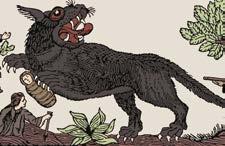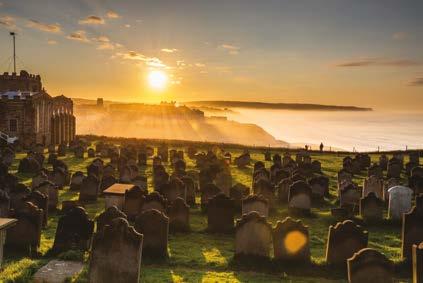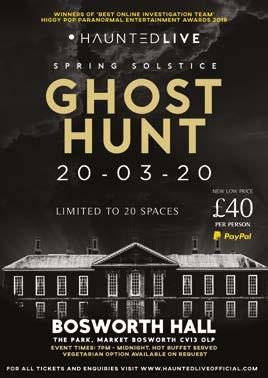
13 minute read
BARK AT T’MOON … Mike Covell, A ‘reight’ champion that lad
WHO LET T’DOGS OUT? By Mike Covell, t’Yorkshire Historian
THE GHOST DOGS OF YORKSHIRE W hen we think of spectral dogs, and phantom hounds, the first thought would be of The Hound of the Baskervilles, by Sir Arthur Conan Doyle, yet when we go back through history there are many stories of spectral hounds that roam the countryside. In fact, Bram Stoker included a mysterious black dog in his book Dracula and stated that it was seen running up the 199 steps towards St. Mary’s Church and Whitby Abbey. Some years ago, when I was enlisted in an investigation of the infamous “Beast of Barmston Drain,” which the media took it upon themselves to name “Old Stinker,” I was asked whether the sightings of the strange creature could be ghostly, given that Yorkshire has many ghost stories involving strange dogs. Fascinated by this theory I began researching these stories and compiling a long list of the locations and legends attached to them. These creatures are said to be shapeshifters, and are often associated with the Devil, often being described as “hell hounds.” They are most often reported in rural areas, and are common around crossroads, places of execution, and old ancient pathways such as ley lines and cursus. It is unclear when the stories began with influences coming from various cultures in European mythology,
Advertisement
Celtic mythology, and Germanic mythology. In Greek Mythology they had Cerburus, in Norse mythology they had Garmr, and in Welsh mythology they had Cwn Annwn. Many stories connect the black dogs to the underworld, claiming that they are guardians. Some stories go even further, with tales of the Barghest and Black Shuck being directly
linked to stories of harm and even death. Across the UK the names of these dogs change from region to region, including names such as Barguist, Black Shuck, Black Shock, Grim, Gytrash, Old Shuck, Padfoot, Shag, Shuck, Shock, Shrieker, Striker, Trash, Yeth Hound, and Wisht Hounds.
“It’s
chuffin’
roastin’
out.”
A684 NORTHALLERTON TO LEEMING BAR

The A684 that runs between Leeming Bar, in the west, and Northallerton, in the east, is said to be haunted. The road between the two is approximately 5.1 miles / 8.2 km and takes an average of 8 minutes to drive along, taking the driver over Scruton Stell, the River Swale, through Morton-on-Swale and past Ainderby Steeple, before it crosses over the River Wiske into Northallerton. It is said that the road is haunted by a mysterious black dog. A lady travelling between the two locations along the road saw the creature jump out in front of her vehicle, she slammed on, expecting to hit something, and the passenger watched on in horror, as the dog seemingly went through the bonnet. They noticed that the creature had no facial features but had large floppy ears and was “shadow like.” It was later said that when the car arrived at its destination, the occupants told a friend, a male, what they had seen, and he later committed suicide, leading them to believe it was a portent showing them that something was about to happen.
BARGUEST Legends and superstitions regarding big black dogs and spectral hounds might sound like a Sherlock Holmes adventure, or an episode of The X Files, but sightings of such creatures go back centuries in Great Britain, with many sightings taking place in North Yorkshire.

Brigham is said to be haunted by a mysterious black dog. For many years Britain has been plagued by mysterious reports of large black phantom dogs that display supernatural abilities, from drawing thunder and lightning, to their glowing red eyes, and their ability to make their observers drop down dead. (If you did drop down dead after seeing such a dog, how would you pass on the story……)
Brigham’s Brigham Lane End, where four roads meet, is known for a phantom Boggle known as Willie Sled’s dog. Willie Sled used to attend to visitors to Brigham, and as such the boggle is named after him. The creature has also been associated with the sand pit on the south western end of Brigham Lane which stood opposite the Wesleyan Methodist Chapel.
“Ah reckon nowt ter that.”
On Saturday February 28 th 1880, The Leeds Mercury reported on “The Padfoot tradition,” in which it talked about large black dogs that had been roaming around the region. It mentioned that sightings had taken place in Tadcaster, Wakefield, Brighouse, and Halifax, as well as York, which was known as “The Barguest of York.”
On Saturday July 3 rd 1880, The Leeds Mercury stated that in some areas of North Yorkshire the creature was called “The Caplethwaite.” There was also some discussion as to the origin of the creature, with some claiming that it was ghostly, spiritual, like a boggart, or nature spirit, while others argued that it was a flesh and blood creature.
The subject arose again on Saturday May 20 th 1882, when The Leeds Mercury looked at cases around the British Isles, and included reports on creatures from boggarts, to barguests. The Leeds Mercury would later take on the stories again on Saturday September 26 th 1885, when it talked about sightings of the barguest in the region, this time round it stated that some people had seen it shapeshift into a donkey with chains on its feet. One such eyewitness, an unnamed collier, claimed to have seen the dog-donkey walking towards him with chains rattling and clanking at every step in the dead of night. He took the opportunity to ride the dog-donkey home! Once the creature and its hard-working rider arrived back at the cottage, the creature sank into the earth and vanished.
According to The Yorkshire Herald, and The York Herald, dated Saturday December 24 th 1892, there was a barguest in the Nidderdale region. The description of it states that it was a mysterious sort of dog with glowing eyes of fire and big teeth. It made a strange brushing sound as it walked.
COTTINGHAM’S GHOSTLY DOG The Fair Maid is a well-known public house and eatery in Cottingham and stands on a very busy road with footfall from passing traffic and on a busy Hull to Cottingham bus route. The public house itself has a large imposing three storey façade and dominates the corner of Baynard Avenue and Hallgate Junction. Initially the property was Westfield House and owned by the Lambert family. From here Lamberts Wine and Spirit Merchants was run. Among the family members was Rev. Canon Malet Lambert. In 1935 the property was owned by Edgar Grotrian. For many years, the Barclay Club had operated from the property, but in 1951 Mr. Brown purchased the property and turned it into the Westfield Country Club. When it was first opened as the Westfield Country Club the first and second floors were split into self-contained flats, with the ground floor containing a games room, with table tennis, and a full size snooker table, there was a bar, and a dining room, offering a mixed grill, and had a membership of 500 members. It was here some years ago that an eyewitness reported seeing a large red setter that ran in front of the pub and around the corner, subsequently vanishing. The dog was seen again days later but once again vanished.



“‘E’s a reight bobby dazzler.”

According to an article that appeared in The Burnley Express, on Saturday April 2 nd 1927, Grassington has a barguest, or in this case a Bar Ghost, that was seen sitting on top of a five barred gate, and described as being able to shape-shift but usually taking on the form of a dog. It was said that the creature had large round saucer shaped eyes, which emitted sparks of fire, and smoke and fire came from its nostrils. It was said that the creature took great delight in scaring travellers.

On Friday July 16 th 1954, The Barnoldswick & Earby Times reported that Ted Williams, and his friends John and Clifford had gone in search of the barguest at Grassington. According to the report they found a large five barred gate-cumguidepost, and written on it with white paint it stated, “This way to the ghouls.” They walked along a path, and up through past a river, but did not see anything spooky!
“And ahm ‘appy as a pig in muck.”
GRINDLESFORD
Longshaw Moorland at Grindlesford, boasts a spectral black dog, described in some accounts as “padfoot,” other reports as “barguest,” and other reports as “black shuck.” The creature has been described as terrifying but when confronted with the creature eyewitnesses have screamed at the dog, causing it to retreat and run off.

“I’m chuffed t’bits wi’ that.”
Ivelet is a small hamlet in the Yorkshire Dales, which in turn is situated in North Yorkshire, it stands approximately 1 mile / 1.6 to the west of Gunnerside in Swaledale. The single span Ivelet Bridge over the River Swale dates from 1687 and was an important crossing point on the 16-mile Corpse Way from Muker to the Churchyard at Grinton, which was once the only consecrated burial ground in the dale.
A headless dog is reputed to haunt the Ivelet Bridge. It silently runs up the bridge before jumping over the wall and diving into the River Swale below. This phantom is considered locally to be an ill omen and a portent of death.
“That’s proper champion, that, lad.”
KETTLENESS BLACK DOG
A schoolmaster, who was visiting Kettleness with his two friends near Whitby encountered a ghostly dog on their journey. It was said that they were all overcome with great fear, and when looking out over the shoreline towards the sea, they saw the phantom hound. They claimed that it was so large that it could not me a mortal dog, and that it was silent in its movements, and appeared out of nowhere!



As quickly as they had seen it, the creature vanished.
THE GHOST DOG OF HUBBERHOLME
Hubberholme is a small village that stands in Upper Wharfedale in the Yorkshire Dales, North Yorkshire. The village pub, The George Inn, it is said was once the vicarage to the church, but historical maps show the vicarage to be further along Dubbs Lane.
The land around Hubberholme, which is said to be haunted by a ghostly dog, described in some cases as being big and grey, and in other sightings described as looking like a whippet. The dog had been seen on the road at regular intervals on the road between Hubberholme and Cam Houses
KIRKBY OVERBLOW


Kirkby Overblow is situated in Harrogate, between Wetherby and Harrogate, and stands to the west of Sicklinghall and to the east of Leeds Bradford International Airport. It is claimed that a starved dog, which was abandoned by its owner, haunted farmland in the area. The dog, which in some versions of the story was a black dog, and in other versions was a sheepdog, was left in the fields and starved to death.
York Minster is said to be haunted by a spectral dog; whose barks can be heard during the evening. It is said that the dog belonged to a stonemason working on the Minster, and that the dog was named Seamus. It is claimed that Seamus and his master were not liked by the other stonemasons, so they bricked the dog up behind the wall, and the dog died in the darkness.

“Eeh I’ll go t’foot of stairs!”
THE PHANTOM DOG AT SOUTHBURN
Usually when we talk about ghostly dogs we mean large black beasts such as Padfoot and Guytrash, but in this case the phantom dog was nothing more than a family dog, a pet, a part of the family, who had met with an early end, and returned from the other side.

A family had to have their dog put down after it had bitten a rat, but two years later the phantom dog returned, and Poppy, as she was called, looked so real the family thought that they could reach out and touch her.


“Where there’s muck, there’s brass.”
TROLLERS GILL Trollers Gill is a limestone gorge that stands in North Yorkshire. It stands approximately 4.7 miles / 7.5 km southeast of Grassington, and close to the village of Skreholme. The gorge is approximately 0.5 miles / 0.8 km in length and is also known locally as Trollerdale. The origin of the name of the gorge is magical in itself, with some sources stating that the name came from trolls who lived in the area, although it is more likely that the gorge took its name from the word “Geir” which is Danish and means a “triangular piece of land that ends in a chasm.”
It has been claimed for some years that the gorge is home to the mysterious and mythical dog known as the Barghest, or Padfoot, who, it is claimed, can turn people into stone with a single look!
The story really became popular in February 1880, when The Leeds Mercury, featured several stories on the mysterious dog, with letters, theories, and even poetry that talked about the creature. On Saturday March 6 th 1880, the story was further elaborated on when one writer in The Leeds Mercury claimed that Padfoot would arrive to foretell a death.
On Monday September 10 th 1888, The Hull Daily Mail covered the story of Troller’s Gill, erroneously named as Trowler’s Gill in the article. It stated that the area had a well-known legend about a man named Trowler (I assume they meant Troller), who had spent the night at the Gill, and while he was there he met, and was subsequently killed, by the Barguest, which was referred to as “The Spectral Hound of Craven.” The man was killed, and the Gill was renamed in his honour.
The story would again be told in The Leeds Mercury, on Saturday December 10 th 1892, in which it stated that one of the major bugbears in the district was the Barguest, known locally as “The Spectral Hound of Craven.” The short snippet states that it haunts the woodland and roads around Craven, especially at Troller’s Gill. It is claimed that the creature avoids the sun, and to meet it at midnight would mean certain death from fright. It is said that the creature resembled a dog, black, curly, gruesome, carrying a chain behind him which is said to rattle to warn off potential victims. It is claimed that a man, who was drunk, met the creature at Troller’s Gill and he was “fleyed out of his wits.”
Till t’next time, Mike
Does your village, town, city or county have mysterious beasts, curious cats, deadly dogs, terrifying tortoises and such forth, please do let us know… Email animalmagic@hauntedmagazine.co.uk and tell us more.












